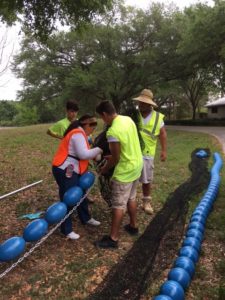What’s the difference between a billy goat and a Watergoat?
Watergoats are far more effective at “digesting” common litter including plastic bottles and aluminum cans.
An underwater net held in place with stainless steel connected to buoys, Watergoats are anchored on land near major drainage outfalls where they can capture an average of 125 pounds of trash – some up to 300 pounds — per month. Catching that litter in a small space before it escapes to larger bodies of water makes it more efficient to collect and dispose of trash.
Collecting Trash Close to Home
More than eight million tons of plastic end up in oceans every year, even if it was initially discarded far inland. Solving the global problem of marine litter begins at home, says Mark Maksimowicz, who heads the not-for-profit organization that makes Watergoats in the Tampa Bay region.

Since Maksimowicz began building Watergoats more than 10 years ago, more than 100 tons of trash has been harvested from the 24 Watergoats installed at major drainage outfalls into Tampa Bay. “Watergoats are only installed on stormwater outfalls that are connected to a large municipal grid – most of them garnishing debris from at least 10 city blocks or more,” he said.
The data isn’t perfect, largely because it’s collected by volunteers, but it includes everything that washes down a storm drain, from plastic bottles and aluminum cans to dirty diapers and dead animals.
Volunteers Critical to Success
And while the technology may be simple, the key to a Watergoat’s success is the people who clean them on a twice-a-month basis. “We work with organizations who are able to maintain them,” Maksimowicz said.

Scheduling the clean-ups depends upon the amount of rain that falls in the watershed, pushing debris into the bay, notes David Westmark, co-founder of the Blue Turtle Green Bird Society who can see two Watergoats from his office at the Florida Fish and Wildlife Conservation Commission’s office in downtown St. Petersburg.
“We usually do ‘pop-up’ clean-ups if we get a lot of rain, or plan on clean-ups every two weeks or so,” he said. “It only takes a couple of people to get 200 or 300 pounds of trash in a half hour. There’s no way we could walk the streets or a beach and pick up that much trash that quickly.”
They’re also the last opportunity to capture trash before it enters Tampa Bay, notes Christina Arenas, environmental program manager for Keep Tampa Bay Beautiful, which recently installed a Watergoat south of Ybor City. “We collected more than 300 pounds of trash our first clean-up, and now average about 150 pounds every other week,” she said.
Students at nearby Hillsborough Community College volunteer for the clean-ups – and then learn what happens to their litter, she said. “When it collects that way, it’s very easy to see for them to see the impact of littering.”
Even homeowner associations see the benefits of capturing trash enters waterways. One is planned for Crescent Lake next year with maintenance by neighbor groups, Maksimowicz said.

Pinellas County also uses Watergoats at major outfalls. “We love the Watergoats,” said Kelli Hammer Levy, the county’s environmental management division director. “They’re a great tool in our toolbox.”
Easy to handle
The Watergoats are designed so that people doing the clean-ups don’t need to get their feet wet. They can be unhooked on one side, moved to land and then cleaned with long-handled nets like pool scoops, Maksimowicz adds. Although they can be built to span up to 100 feet, most are under 80 feet. “That much trash can be a challenge to move,” he notes.
Distributed for Free
Watergoats are available to community groups at cost, and the organization now has a 501 (c) (3) status so it can accept corporate donations. “We’re hoping to work with businesses to sponsor Watergoats near their facilities,” said Maksimowicz.
Cost, of course, depends upon the size of the Watergoat, and ranges from about $2,300 to $3,200. Grant funding may be available to assist with installation, but ongoing maintenance commitments are usually required and must be provided by volunteers.
The Watergoats are designed to last at least 10 years, and some of the new versions include special cloth netting hat captures microplastics in larger canals, he adds. “The first Watergoat we installed was at Bayboro Harbor near USF and we just replaced it after 10 years,” he said.
It is important for us at Bay Soundings to bring you the information you may find interesting or useful. Reference in this article to any specific commercial product or organization name is for informational purposes and does not constitute endorsement, recommendation, or favoring by Bay Soundings. This is just one example of efforts to keep litter from reaching our waterways Florida, to see more options please scroll through our Pinterest Board – we’ll add more examples whenever we see them.
[su_divider]
